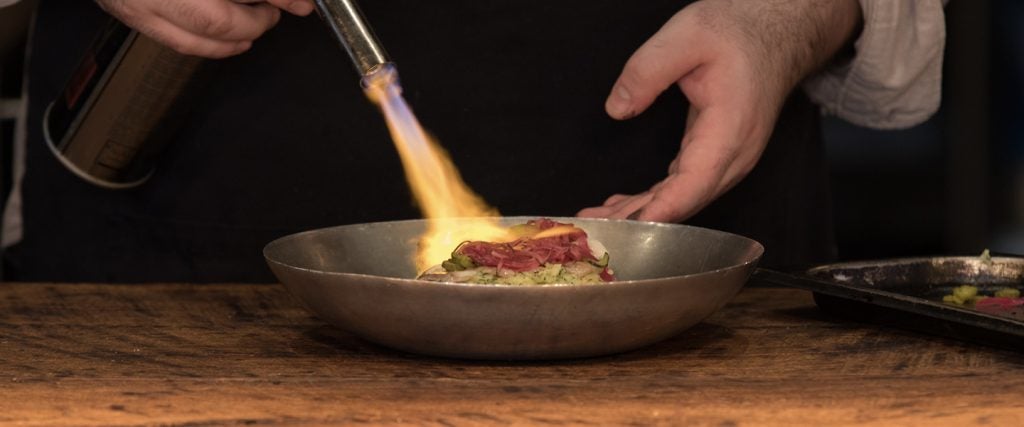The fact of the matter is, your home cooking simply does not taste like the stuff that comes from a commercial restaurant kitchen — and the biggest reason isn’t talent or ingredients, it’s the fire.
Consider that many commercial ranges put out more than 30,000 BTUs — upwards of three times the heat of a conventional home model, making for incredibly hot pans that can cook super fast and leave a gorgeous char on everything they touch.
This is doubly true with the Chinese wok range, which basically resembles a jet turbine more than anything else. It’s no coincidence that a stir-fry from your neighborhood Chinese takeout joint seems to just taste more complex than the version you’ve whipped up at home, even if you used the same recipe.
Some enthusiasts have chased after modifications and accessories to increase the potential of their stove; others just decide to fork over $10,000 to get a state-of-the-art range that puts out insane BTUs. Doing so is to neglect a far cheaper, and more elegant, handheld tool: the humble kitchen blowtorch.
I use it every single time I make any kind of stir-fry, no matter whether it involves vegetables or protein, and the aroma of the char, so reminiscent of wok hei (Cantonese for “wok energy” or “wok breath”), never fails to impress. It’s perfect for fried rice and any fried noodle dish — all I do is use my blowtorch in one hand while moving the pan in the other, watching the flame vaporize oil and moisture into smoke. The goal isn’t to char any ingredients, per se, but to hasten the Maillard reaction and infuse the dish with the flavor of fire.
This is a common, even trendy technique in Asia, where you’ll see torches used on all manner of street foods and restaurant meals; I love the vendors at Tsukiji Fish Market that cook fresh scallops in the shell, using a charcoal grill plus a blowtorch to brown the tops. Koreans, too, are all about blowtorching these days, using it on Korean barbecue dishes and skewered meats.
Meanwhile, in the West, the first and only thing people can really think of torching is… creme brulée. That is an objectively incredible dessert, but the association does a disservice to the torch itself. Odds are, once you start blowtorching shit, you won’t want to stop — and will actively seek the excuse to bust out the blue flame.
Got some uneven, less-cooked patches on the crust of a steak or a roast? A torch gives you precise power and control, allowing you to “fix up” that food after you pull it off the stove or out of the oven. Need to crisp up a bit of fish or chicken skin? Ditto: There’s nothing like the dry, intense heat of a torch to make it crackle again.
Melting cheese (on anything) is a 10-second task with a torch, as is charring the skin of vegetables like peppers and tomatoes. Using a torch on a low heat is the perfect way to toast up chiles for a Mexican salsa roja, or you can also use it to create herb or wood smoke for an infusion (or just for a dramatic presentation). You can use it for cocktail party tricks, lighting up cinnamon, bitters and citrus oils as the perfect finish to a drink. We’ve already talked about creme brulée, but don’t forget that you can basically brulée anything you want; my favorite is just putting coarse sugar on grapefruit, strawberries and tart stone fruit, then caramelizing it with a fast torching.
Oh, and do you like s’mores? How do you feel about having s’mores any time you want, including on top of a mug of hot chocolate, all while cozied up on the couch instead of in the great outdoors?
Somehow, I’m still using a $35 butane torch I bought from Bed Bath & Beyond back in 2012; despite a decade of wear, it’s going strong. You might prefer a bigger model that screws directly onto a can of butane, or even larger propane torches found in construction stores. But I find that, as long as you can get a fierce blue flame that extends a few inches, the specifics of the design and gas output aren’t all that important. (Do avoid cigar butane lighters and cheap “creme brulee” torches, which will disappoint.)
And be aware that using low-quality fuel or janky torches can leave your food tasting nasty; a yellow or orange flame indicates incomplete combustion, which means you’re covering your dish in carcinogenic soot. If the torched dish smells like lighter fluid, it’s an issue with the kind of flame you’re using.
Otherwise, using a torch for cooking is a simple, affordable and genuinely entertaining path to new creativity in the kitchen. You’ll wow family and guests alike, because humans just really dig flames. More importantly, it just might make cooking less of a chore — transforming another weekday meal into something remarkable.

